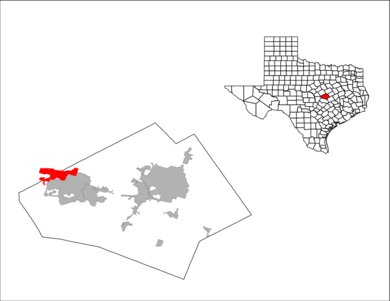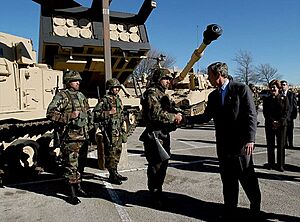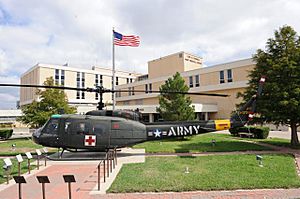Fort Cavazos facts for kids
Quick facts for kids Fort Cavazos |
|
|---|---|
| eponym: Gen. Richard E. Cavazos, USA | |
| Killeen, Texas | |
     
Shoulder sleeve insignia of major Ft. Cavazos units
|
|
| Coordinates | 31°08′23″N 97°45′57″W / 31.13972°N 97.76583°W |
| Type | Army post |
| Area | 332.05 sq mi (860 sq km) |
| Site information | |
| Owner | Department of the Army |
| Controlled by | United States Army |
| Status | Active |
| Site history | |
| Built | 1942 |
| In use | 1942–present |
| Garrison information | |
| Current commander |
LTG Sean C. Bernabe |
| Garrison | III Armored Corps First Army Division West 1st Cavalry Division 36th Engineer Brigade 13th Sustainment Command 3rd Cavalry Regiment 504th Battlefield Surveillance Brigade 89th Military Police Brigade 1st Medical Brigade Operational Test Command 407th Army Field Support Brigade 48th Chemical Brigade 69th Air Defense Artillery Brigade 11th Signal Brigade 3rd Security Force Assistance Brigade |
Fort Cavazos is a large United States Army base located near Killeen, Texas. It is named after General Richard E. Cavazos, who was the first Hispanic four-star general in the U.S. Army. Before 2023, it was called Fort Hood. The base is located between the cities of Austin and Waco.
Fort Cavazos is a very important place for the U.S. Army. It is the main home for the III Armored Corps and First Army Division West. It also houses the famous 1st Cavalry Division and the 3rd Cavalry Regiment. The base is huge, covering about 332 square miles (860 square kilometers). In 2010, over 53,000 people lived there. It was once the most populated U.S. military base in the world.
Contents
History of Fort Cavazos
How the Base Started
Fort Cavazos was built during World War II. The Army needed a large, open area to test and train with new tank destroyers. These were special vehicles designed to fight enemy tanks. In January 1942, the War Department chose Killeen, Texas, as the perfect spot.
The construction of the camp began quickly. About 300 families had to move from their homes to make space for the base. Some small communities were removed for the construction. The Army allowed the land to be used for grazing animals, which still happens today. The camp officially opened on September 18, 1942. It was first named Camp Hood, after a Confederate General named John Bell Hood.
By the end of 1942, about 45,000 troops were training at Camp Hood. In 1943, this number grew to almost 95,000 troops. As World War II ended, the base's mission changed. Training slowed down, and the focus shifted to sending soldiers home.
The Cold War Era
After World War II, Camp Hood became a permanent base for armored training. On April 15, 1950, it was officially renamed Fort Hood. In 1954, the III Corps moved to the base. They helped train combat units.
One of the most famous people to train at Fort Hood was Elvis Presley. He arrived on March 28, 1958. He was treated like any other soldier, even though he received a lot of mail! In September 1961, the III Corps returned to Fort Hood. The 1st Armored Division also moved there, making it a home for two major divisions.
During the Vietnam War
In the late 1960s, Fort Hood trained many soldiers and units for the Vietnam War. After the war, the base was modernized. New buildings replaced older wooden ones. A new hospital, Darnall Hospital, opened in 1965.
In 1969, a part of the base called Killeen Base was renamed West Fort Hood. Its airfield was named Robert Gray Army Airfield, after a pilot from Killeen who fought in World War II. In 1971, the 1st Cavalry Division moved to Fort Hood from Vietnam.
Testing New Military Gear
Since the 1970s, Fort Cavazos has been important for testing new military equipment. The base helped introduce the M1 Abrams tank, the M2/3 Bradley Infantry/Cavalry Fighting Vehicle, and the AH-64 Apache helicopter.
In 1975, the 1st Cavalry Division became the Army's newest armored division. They were the first to use many new technologies. These included the AH-64 Apache attack helicopter and the Multiple Launch Rocket System.
Deployments in the 1990s
In August 1990, units from Fort Hood were sent to Southwest Asia for Operation Desert Shield. They helped protect Saudi Arabia. After the Gulf War, soldiers from Fort Hood continued to serve in the Persian Gulf.
From 1992 to 1993, soldiers from the base went to Somalia for Operation Restore Hope. They helped with disaster relief and support. In 1994, Fort Hood units took part in other operations in the Caribbean and Central America.
In 1995, the 2nd Armored Division at Fort Hood was renamed the U.S. 4th Infantry Division. This division became the Army's "Experimental Force." They tested new ways of fighting and organizing.
Since the 1990s, units from Fort Cavazos have also supported peacekeeping efforts in places like Bosnia and Herzegovina. The base also helps with disaster relief efforts both in the U.S. and internationally. For example, they helped after an earthquake in Managua, Nicaragua. The base has also been modernized with new buildings and training areas.
The 2000s and Beyond
In the early 2000s, the Army continued to modernize. Fort Hood was the first base to privatize its housing. This meant new and remodeled homes for soldiers and their families.
After the War on Terror began in 2001, Fort Hood became a "closed post" for security. Many units from Fort Hood were sent to Afghanistan for Operation Enduring Freedom and to Iraq for Operation Iraqi Freedom. In December 2003, the 4th Infantry Division helped capture Saddam Hussein.
In 2005, units from Fort Hood helped with relief efforts after Hurricane Katrina and Hurricane Rita. They provided food, collected remains, and helped with emergency engineering. In 2009, the First Army Division West moved to Fort Hood.
Important Events at Fort Cavazos
Fort Cavazos has experienced some challenging events.
On June 12, 2007, a soldier named Lawrence George Sprader, Jr. was found dead after going missing during a training exercise. He died from heat and dehydration. An Army report found that errors by trainers contributed to his death.
On November 5, 2009, a shooting happened at the Soldier Readiness Center. A U.S. Army Major and psychiatrist, Nidal Malik Hasan, opened fire. He killed 13 people and wounded 32 others. He was shot and arrested by police officers. In 2013, Hasan was found guilty of murder and sentenced to death. A memorial was built in Killeen in 2016 to honor the victims.
In 2011, a former soldier named Naser Jason Abdo was arrested near Fort Hood. He told investigators he planned to attack soldiers at the base. He was later sentenced to life in prison.
On April 2, 2014, another shooting occurred on the base. Three people died, and fourteen were wounded. The shooter was identified as Ivan Lopez, an Iraq War veteran.
Changes and Renaming
In 2020, there was a discussion about renaming U.S. military bases that were named after Confederate generals. Fort Hood was one of these bases. Concerns about soldier safety and leadership at the base also came up.
On May 24, 2022, a special commission recommended that Fort Hood be renamed Fort Cavazos. This was to honor General Richard E. Cavazos, the first Hispanic four-star general in the U.S. Army. The recommendation was approved, and Fort Hood was officially renamed Fort Cavazos on May 9, 2023. The airfield was also renamed Yoakum–DeFrenn Army Heliport.
Today, Fort Cavazos is home to nearly 65,000 soldiers and their families. It continues to be a vital military installation.
Anti-War Activities
Fort Cavazos has also been a place for anti-war activities. During the Vietnam War, a coffeehouse called the Oleo Strut opened near the base. It was a place where soldiers could discuss their views on the war.
In 2009, a new place called the Under the Hood Café opened. It continued the tradition of being a center for anti-war activists to support soldiers. The café closed in 2014.
Demographics

Fort Cavazos is like a small city. As of 2020, about 28,295 people lived there.
| Race | Number | Percentage |
|---|---|---|
| White (NH) | 13,509 | 47.7% |
| Black or African American (NH) | 4,521 | 16.0% |
| Native American or Alaska Native (NH) | 180 | 0.6% |
| Asian (NH) | 1,023 | 3.6% |
| Some Other Race (NH) | 116 | 0.4% |
| Mixed/Multi-Racial (1) | 1,748 | 6.2% |
| Hispanic or Latino | 6,844 | 24.2% |
| Total | 28,295 |
Most of the people living on the base are young. In 2000, about 33% of the population was under 18 years old. The average age was 21 years old. This is typical for military bases because many soldiers are young. The average household income on the base in 2000 was about $32,552.
About the Military Base

Fort Cavazos is a very large U.S. military base. It is home to many important units, including the III Armored Corps, the 1st Cavalry Division, and the 13th Sustainment Command.
Before the Soviet Union broke up, Fort Hood was known as the largest military base in the "free world." Today, it is a gated base, meaning access is controlled. However, some parts are open to the public, like the 1st Cavalry Division Museum and the Belton Lake Outdoor Recreation Area (BLORA). The base also hosts public events, like a large Independence Day fireworks display.
The housing on Fort Cavazos is managed by a private company. Many homes have been remodeled or rebuilt. The nine schools on Fort Cavazos are part of the Killeen Independent School District.
Fort Cavazos is divided into three main parts: the main cantonment, West Fort Hood, and North Fort Hood. The main cantonment has its own airfield, Yoakum–DeFrenn Army Heliport. West Fort Hood has a second airfield, Robert Gray Army Airfield, which is also used for civilian flights (Killeen Regional Airport (GRK)).
Notable People Who Lived Here
Many interesting people have lived at Fort Cavazos, including:
- Mark Adickes – a football player and surgeon
- Ciara - a famous R&B singer
- Elvis Presley – the legendary singer and actor
- Robert Griffin III – a football player
- Tamera Mowry – an actress
- Tia Mowry – an actress
- Lucas Till – an actor
- Anna Todd – an author
- Yoon Mi-rae – a South Korean singer
See also
 In Spanish: Fort Hood para niños
In Spanish: Fort Hood para niños




